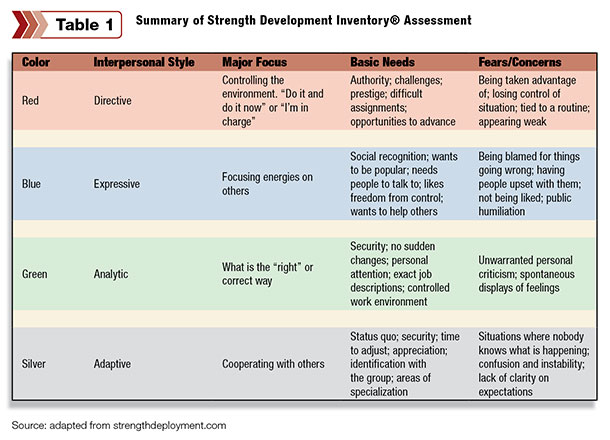America celebrated its independence on July 4 by proudly displaying the colors of red, white and blue. These three colors are associated with freedom and visibly featured on the U.S. flag.In the field of study of personality styles and assessments, colors have become important elements to signify diverse personality types people possess. By taking technical information, which makes up one’s behavior, motivation and attitude, and corresponding it with a color – human resource and leadership professionals have found an effective way for individuals to remember their personality style and those of others.
After completing a personality assessment, you may hear people say things like, “I know she is a blue, she is so creative,” or “He is a green, so I’m not surprised he read the instructions word for word” rather than referring to the more formal technical personality terms.
Like the definition of leadership, there are several personality type assessments used in the business and human resource field. Two common assessments are Myers Briggs Type Indicator (MBTI) and DISC assessment. The different assessments offer guidelines for one to gain a new understanding of personality characteristics, including their own personality traits.
The personality assessment test I like to use and refer to the most often is called the Strength Development Inventory (SDI). In a generalized format, I will explain it in this column to emphasize how personality type assessments can aid in team building and balance in your workplace.
I like the SDI tool because it fits well in human resource management. It is more of a motivational assessment tool as opposed to just measuring your behaviors of your personality. SDI’s website emphasizes that the assessment goes below the surface of the behaviors into the motivations and the values that underlie and influence those behaviors.
By understanding what motivates us in our lives to do the things the way in which we do, we can better manage our own behaviors and also our relationship with others. When people understand themselves to a higher degree and what they value in life, they will also understand what motivates others and be more sensitive to the needs, motivations and values of people they work with.
Keep in mind, this column is only an introduction to the topic of personality assessments and styles. It is best to learn and study this more by participating in personality testing conducted by a trained professional or go online and conduct a full assessment offered by one of the professional personality assessment tools.
Table 1 is a summary of the SDI assessment tool which can get you started focusing on your motivations, values and style. Take a moment to read through the table and see if you can determine your color.
Did you identify with a color? Did you determine the colors of your co-workers or your supervisor? The most important element is not what color you are but that you learn about your values, what you portray to other people, and how you can reach out to others that fit into a different color category.
I will walk through one example that goes more in-depth about how a person of a particular color type can utilize this information to learn more about working with others.
For example, if you realize that your boss is a “Red (Directive),” here are some tips to consider when interacting with them: Blue, Green or Silver personality styles should be clear, specific and to the point when visiting with a “Red,” they should stick to business and definitely come prepared with information such as objectives, support material, etc., when asking a question or proposing a change.
In addition, those working with a “Red” personality style should present material in a logical format, provide alternatives and choices, and if you end up disagreeing, make sure you take issue with the facts, not the person, support rather than direct or order, and depart graciously.
If you are a supervisor who is classified as a “Red” personality style, here are some tips to be more effective when working with the other three personality types: Aim to develop more patience with people, learn to negotiate with others, develop greater awareness of other people’s needs, and work to participate more with others.
According to SDI’s research, more than $359 billion are wasted on conflict in workplaces each year. Think how much more productive your supervisor/employee relationship or employee-to-employee relationship would be if you really understood the other person and could prevent miscommunication and conflict.
I encourage those in supervisory roles to locate a trained professional in your geographical area to conduct a personality type test for you and your employees, to help to build a solid team and foundation for your farm, ranch or agribusiness workplace. ![]()

Lynn Gordon
Ag Leadership Specialist Assistant Professor
SDSU Extension and Department of Teaching, Learning and Leadership










